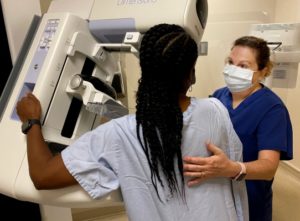
Michelle Kincaid, a mammography technologist at Naval Hospital Jacksonville, assists a patient during a mammogram. TRICARE covers an annual screening mammogram for women age 40 and over. U.S. Navy photo by Deidre Smith, Naval Hospital Jacksonville
BETHESDA, MS — Accessibility to healthcare is an important determinant in cancer survival. Studies of patients in the military health system (MHS), which provides universal care to uniformed servicemembers, military retirees and family members, have shown higher survival rates for several forms of cancer compared to the general U.S. population. A new study has added breast cancer to that list.
Led by Jie Lin, PhD, senior epidemiologist at the John P. Murtha Cancer Center Research Program, Uniformed Services University of the Health Sciences, the study analyzed data of 31,548 patients from the Department of Defense’s Automated Central Tumor Registry (ACTUR) and 63,096 from the National Cancer Institute’s Surveillance, Epidemiology and End Results (SEER) program. The two populations were matched on age, race and diagnosis year to minimize the influence of demographic differences on survival. Multivariable Cox regression hazard modeling was used to estimate hazard ratios (HRs) comparing ACTUR with SEER. Multivariable logistic regression was used to estimate odds ratios (ORs) comparing stage and treatment receipt. 1
“The major finding was that the MHS breast cancer patients were 24% less likely to die overall, compared to those in the U.S. general population,” Lin told U.S. Medicine. “When comparing the two populations by age, race or tumor characteristics, the results remained similar.”
Nevertheless, the difference between the two populations tended to be larger for Black patients than white patients, Lin said. Black patients in the MHS had 37% lower mortality than those in the general population, while the corresponding percentage was 22 for whites.
ACTUR patients also were less likely to present with later-stage tumors compared to the SEER patients, the study found. But for ACTUR patients with more advanced tumor stages, the survival benefit was more evident, suggesting the potential effects of higher accessibility to more intensive treatment in the MHS than the general population as a whole.
Improved Care
In addition to the mortality difference between Blacks and whites, a subset analysis comparing active-duty patients and their matched SEER patients (the general population) found a 41% lower mortality for active-duty women than their SEER counterparts, while the corresponding percentage was 23% for nonactive-duty patients compared to their matched SEER patients, Lin said. “While active-duty patients may be generally healthier than matched patients from SEER and thus better survival, they usually receive care at military treatment facilities [vs. care at civilian medical facilities]. The improved survival may suggest improved cure and survival at military treatment facilities,” she added.
The new study bolstered evidence that universal access to healthcare through the MHS improves cancer survival. Previous, separate studies by the group have shown ACTUR patients have a significant survival advantage in lung cancer, glioma, sarcoma and, most recently, colon cancer.
These findings, as well the high prevalence of breast cancer—particularly in the MHS—prompted the current study, said Craig D. Shriver, MD, professor and director of the Murtha Cancer Center Research Program and co-author of the study.
“Breast cancer is the most common cancer with the second highest death rate out of all cancers among U.S. women,” Shriver said. “Breast cancer is also the most common cancer among active-duty service women and other female MHS beneficiaries. The elucidation of whether breast cancer patients in the MHS have longer survival than the general population can provide evidence on the impacts of universal medical care on prognosis of breast cancer patients.” The findings did just that.
“Our findings from this breast cancer study add to the findings from our previous studies on other cancers, and further support the overall rather than cancer-site survival benefits of the MHS,” he said.
- Lin J, Hu H, Shriver CD, Zhu K. Survival among Breast Cancer Patients: Comparison of the U.S. Military Health System with the Surveillance, Epidemiology and End Results Program. Clinical Breast Cancer. Published: December 01, 2021 doi:https://doi.org/10.1016/j.clbc.2021.11.010

